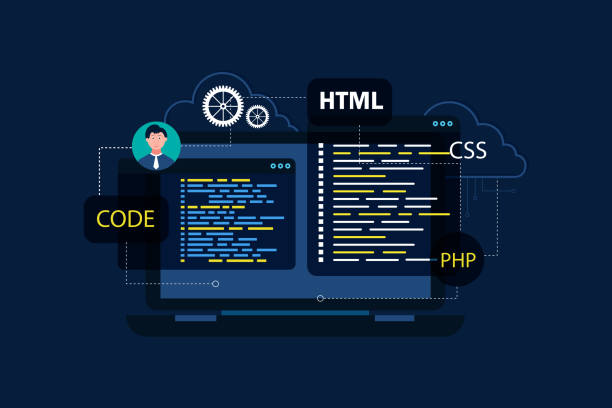Introduction to Secure Website Design and Its Importance

In today’s digital world, where online interactions have become an inseparable part of daily life and businesses, #Secure_Website_Design is no longer a luxury option, but an absolute necessity.
With the increasing complexity of cyberattacks and attackers’ desire to exploit information, #Website_Security has become a focal point.
Cybersecurity in the web domain goes beyond installing an SSL certificate; this concept includes a comprehensive set of preventive measures, secure coding, proper server management, and continuous awareness of new threats.
The main goal of secure website design is to protect sensitive user data, maintain information integrity, and ensure service availability.
Ignoring these aspects can lead to loss of customer trust, heavy legal fines, and irreparable damage to brand reputation.
One of the biggest challenges in the field of secure website design is the increasing complexity of the web ecosystem and the continuous emergence of new vulnerabilities.
From SQL injection attacks to Cross-Site Scripting (XSS), each can be a gateway for attackers to penetrate.
Therefore, developers and website administrators must adopt a proactive and comprehensive approach.
This approach includes continuous training for teams, using secure frameworks, and regularly conducting penetration tests.
A deep understanding of how these attacks work and how to protect against them is the most fundamental step in securing the website.
Without these strong foundations, even the best functional features of a website will be at serious risk.
Are you worried about losing customers because you don’t have a professional e-commerce site?
With e-commerce site design by Rasaweb, forget these worries!
✅ Significant increase in sales and visitor-to-customer conversion rate
✅ Professional and user-friendly design that builds customer trust
⚡ Get free consultation from Rasaweb
Common Vulnerabilities and Website Security Weaknesses
![]()
In the path of #Secure_Website_Design, precise identification of #Common_Web_Vulnerabilities is the first vital step.
These vulnerabilities are weaknesses that attackers can use for unauthorized access, data theft, or disrupting website functionality.
One of the most well-known is SQL Injection, which allows an attacker to inject malicious SQL code into website input fields and gain control of the database.
Another is Cross-Site Scripting (XSS), which allows an attacker to execute malicious scripts in the victim user’s browser.
These attacks can lead to the theft of cookies, session information, or even redirecting users to phishing sites.
The OWASP Top 10 list regularly identifies and ranks these vulnerabilities and is a valuable resource for developers.
Furthermore, reviewing Broken Authentication vulnerabilities, such as weak session management or weak passwords, is of high importance.
Attackers can exploit these weaknesses to impersonate users and gain access to their accounts.
Improper access management and Broken Access Control is another common problem that allows users to access resources or functions for which they are not authorized.
This can include access to administrative pages, sensitive files, or editing other users’ information.
Also, the lack of proper Input Validation for data received from the user can pave the way for various attacks, including Command Injection or uploading malicious files.
Server and software misconfiguration, such as using default settings or not removing unnecessary services, is also a significant factor in website vulnerabilities.
All these points highlight the necessity of a comprehensive approach in secure website design.
Best Practices for Secure Coding and Vulnerability Prevention

#Secure_Coding is a fundamental pillar in #Secure_Website_Design and protecting it against cyberattacks.
This section explores the best practices and techniques that developers should employ to ensure their #Code_Security.
The first and most important principle is thorough validation of all user inputs.
Any data received through forms, URLs, or APIs must be validated and sanitized for type, format, and content before processing to prevent attacks like SQL injection and XSS.
Using Prepared Statements in database interactions, instead of direct string concatenation, is a highly effective method for combating SQL injection.
For XSS, encoding or sanitization of outputs must be performed correctly.
In addition, using reputable and up-to-date web development frameworks that have built-in security features can significantly help reduce vulnerabilities.
These frameworks usually provide internal mechanisms to counter CSRF (Cross-Site Request Forgery), manage sessions, and validate forms.
Proper error handling and logging are also vital; excessive information should not be displayed to users in error messages, as it can provide clues to attackers.
Furthermore, using strong encryption for sensitive data both in transit and at rest is mandatory.
This includes using secure hashing functions for passwords (like bcrypt or Argon2) and secure protocols like HTTPS.
The tables below show some common vulnerabilities and their corresponding coding solutions:
| Vulnerability | Description | Coding Solution |
|---|---|---|
| SQL Injection | Unauthorized database access via malicious inputs | Use Prepared Statements or ORM |
| Cross-Site Scripting (XSS) | Execution of malicious code in the user’s browser | Validate and Encode user outputs |
| CSRF | Execution of unwanted operations in the authenticated user’s browser | Use CSRF tokens |
| Broken Access Control | Allows access to unauthorized resources | Proper implementation of authentication and authorization mechanisms |
By adhering to these principles and also conducting continuous security review of code, the creation of vulnerabilities in the early stages of development can be largely prevented, moving towards secure and stable website design.
This proactive approach is both less costly and significantly increases the final security of the website.
The Role of SSL/TLS Certificates in Enhancing Security and User Trust

One of the most important visual and technical elements in #Secure_Website_Design is the #Use_of_SSL/TLS_Certificates.
This certificate, which enables the HTTPS protocol, encrypts the communication between the user’s browser and the website server.
This encryption prevents eavesdropping, data tampering, and Man-in-the-Middle attacks, ensuring that transmitted information (such as passwords, credit card details, and personal data) remains private and untouched.
The presence of a lock icon in the browser’s address bar and “HTTPS” instead of “HTTP” is a clear indicator to users that the website uses a secure protocol and can significantly increase user trust.
Beyond security, SSL/TLS certificates directly impact SEO as well.
Search engines like Google prioritize HTTPS websites in their search results.
This means that having SSL is not only essential for securing the website, but also helps improve its visibility in search results.
There are different types of SSL certificates, including Domain Validated (DV), Organization Validated (OV), and Extended Validation (EV).
Each offers a different level of validation, with EV certificates providing the highest level of trust by displaying the organization’s name in the address bar.
Choosing the appropriate type of certificate depends on the nature of the website and business needs.
Proper installation and maintenance of an SSL certificate is also part of secure website design.
Ensuring that all resources on the website (images, scripts, stylesheets) are loaded via HTTPS (preventing Mixed Content) and timely renewal of the certificate are of high importance.
Using more modern security protocols like TLS 1.2 or TLS 1.3 and disabling older, vulnerable TLS/SSL versions is also highly recommended.
These measures not only enhance security but also help maintain a positive user experience and ensure compliance with security standards, guaranteeing the stability of the secure website structure.
Tired of losing business opportunities due to not having a professional corporate website? Don’t worry anymore! With Rasaweb’s corporate website design services:
✅ Your brand’s credibility and professionalism will increase.
✅ You will attract more sales leads and grow your business.
⚡ Get a free consultation now to start!
Robust User Authentication and Authorization

Within the framework of #Secure_Website_Design, robust #Authentication_Mechanisms and #Authorization form vital layers of defense against unauthorized access.
Authentication is the process of verifying a user’s identity (e.g., via username and password), while authorization is the process of determining a user’s permitted access to specific resources and functions.
Using strong passwords and proper maintenance policies for them is a basic principle.
This includes enforcing the use of a combination of uppercase and lowercase letters, numbers, and symbols, as well as a specified minimum password length.
In addition, storing passwords as hashes (using strong algorithms like bcrypt) instead of plain text is essential so that passwords cannot be recovered even if the database is breached.
But merely a password is not enough.
Two-Factor Authentication (2FA) or multi-factor authentication adds an important security layer.
With 2FA, in addition to the password, the user must provide a second factor such as a code sent to their mobile phone, a fingerprint, or a hardware token.
This significantly reduces the likelihood of successful Brute-Force attacks or attacks based on compromised passwords and strengthens secure website design.
In the realm of authorization, strict access models (Least Privilege Principle) must be implemented, meaning that each user or role should only have access to the minimum resources and functions required to perform their tasks.
This involves careful review of access at the file system, database, and application logic levels.
Session Management is also a critical part of authentication and authorization.
Sessions must be securely managed, meaning session tokens should be random and complex, transmitted over HTTPS, and have a limited lifespan.
With each login or password change, previous sessions should be invalidated.
Also, to prevent CSRF attacks, using CSRF tokens and ensuring accurate request validation on the server-side is vital.
This comprehensive approach to authentication and authorization forms the backbone of a secure website design and prevents unauthorized access and system misuse.
Database Security and Protection of Sensitive Information

In any #Secure_Website_Design, the #Database is the heart of the system and stores vital information including user data, transaction records, and website configuration details.
Therefore, protecting this information is of paramount importance.
The first step in securing the database is using the principle of Least Privilege for database users; meaning each user or service should only have the access it needs to perform its task.
For example, a user whose sole job is to read information should not have write or delete permissions.
Also, database passwords must be strong and changed regularly.
Data Encryption, both at rest and in transit, adds a vital security layer.
Sensitive data such as credit card numbers or national IDs should be encrypted before being stored in the database.
Using strong encryption prevents information disclosure even if the database is breached.
For data in transit between the application and the database, using an SSL/TLS connection is also essential.
Regular security patches and updates for the Database Management System (DBMS) are also vital to protect against known vulnerabilities.
Regular and secure database backups are also an essential part of a secure website design strategy.
These backups should be stored in separate and secure locations and provide quick recovery capabilities in case of cyberattacks, hardware failures, or human errors.
User input validation (Input Validation) that reaches the database is also crucial for preventing attacks like SQL injection and XPath injection.
Continuous monitoring of database activities and logging can help identify suspicious patterns and ongoing attacks.
By implementing these comprehensive measures, database security can be significantly enhanced, and sensitive information protected against threats, which itself means a website with a high-security design.
The Importance of Regular Security Audits and Continuous Updates

In the world of #Cybersecurity, no #Secure_Website_Design is static and unchangeable.
Threats evolve rapidly, and new vulnerabilities are constantly discovered.
For this reason, regular security audits and continuous updates are not just a recommended action, but a vital necessity for maintaining long-term website security.
Security audits include Penetration Testing, Vulnerability Scanning, and secure code reviews.
These processes help identify weaknesses in the system, configurations, and coding before attackers can exploit them.
Recent news reports show that many breaches have occurred due to untimely patching of systems and software with known vulnerabilities.
Software updates, including server operating systems, web servers, programming languages, frameworks, and libraries used, contain critical security patches that address discovered weaknesses.
Neglecting these updates leaves the website exposed to known attacks.
Also, continuous monitoring of server and application logs is crucial for identifying suspicious patterns and intrusion attempts.
Intrusion Detection Systems (IDS) and Intrusion Prevention Systems (IPS) can automatically detect and block malicious activities.
Comprehensive analysis of website security status should be performed periodically.
These analyses not only help discover technical vulnerabilities but also review security policies, organizational procedures, and employee security awareness.
Phishing and social engineering threats also require continuous training for employees and users.
The table below provides a checklist for regular security audits:
| Security Action | Description | Suggested Frequency |
|---|---|---|
| Vulnerability Scan | Automated identification of known vulnerabilities | Monthly/Quarterly |
| Penetration Test | Simulated attack by security specialists | Annually/After major changes |
| Security Code Review | Manual and automated code review for weaknesses | After each major development phase |
| Review Logs and Alerts | Monitor security events and intrusion attempts | Daily/Weekly |
| Update Systems and Software | Apply new security patches | Immediately (after release) |
By committing to this continuous cycle of auditing and updating, secure website design can be ensured, and it can be kept resilient against the evolving threat landscape.
This is a proactive approach that views security as an ongoing process, not a final destination.
Incident Response and Disaster Recovery Planning

Even with the best #Secure_Website_Design approaches, #Cyber_Threats are real, and the possibility of security incidents never reaches zero.
Therefore, having an Incident Response Plan and a Disaster Recovery Plan is among the most essential security measures for any website.
The incident response plan provides a step-by-step guide for dealing with a security incident, from the moment of identification to its conclusion.
This plan includes the stages of identification, containment, eradication, recovery, and lessons learned.
The goal is to minimize the reaction time and limit the damage caused by the incident.
Rapid incident identification is the first and most critical step.
This requires continuous monitoring of logs, alerting systems, and network traffic.
After identification, the response team must act quickly to contain the attack, for example, by disconnecting infected sections or isolating compromised systems.
The eradication phase involves completely removing the attack vector and ensuring the system is clean of any malware or intrusion.
Recovery means restoring systems and services to normal operational status, typically through healthy and tested backups.
Disaster recovery planning focuses on fully restoring business operations after a major incident such as server failure, a severe DDoS attack, or even natural disasters.
This includes regular off-site data backups, backup servers (Hot/Cold Standby), and emergency communication plans.
Both plans should be practiced and tested regularly to ensure their effectiveness in real-time.
Training teams and defining specific roles for each scenario is also of high importance.
By having these plans, organizations can minimize the risk of damage from incidents and ensure business continuity even in critical situations.
These measures not only contribute to secure website design but also enhance long-term business sustainability.
Research shows 80% of customers trust companies with professional websites more. Does your current site build this trust?
With Rasaweb’s corporate website design services, solve the problem of lack of customer trust and a weak online image forever!
✅ Create a professional image and increase customer trust
✅ Attract more sales leads and grow your business
⚡ Get free consultation
Emerging Threats and the Future of Web Security

The #Cyber_Threats landscape is constantly evolving, meaning #Secure_Website_Design must continuously adapt to these changes.
Some emerging threats shaping the future of web security include more sophisticated attacks based on Artificial Intelligence and Machine Learning, attacks on APIs and microservices, and the proliferation of Internet of Things (IoT) attacks.
The question is, will our traditional tools and methods be sufficient to counter these threats? AI attacks can identify vulnerabilities with unprecedented speed and accuracy and launch more targeted attacks, which requires novel defensive approaches.
The increasing use of APIs in modern web architecture has created new attack vectors.
API security requires special attention to strong authentication, precise authorization, and request rate control.
Also, with the growth of the Internet of Things (IoT), more connected devices are entering the internet, many of which are security-weak and can be used as entry points for cyberattacks on websites, especially in Distributed Denial-of-Service (DDoS) attacks.
In the future, more advanced security technologies such as blockchain for data integrity, decentralized authentication, and AI for anomaly detection and attack prediction will play a more prominent role in secure website design.
The concept of “Security by Design” will gain even more importance, meaning that security should be considered from the very first stages of software design and architecture, not as an add-on feature.
Also, increasing data privacy laws and regulations like GDPR in Europe or CCPA in California, oblige developers to comply with higher security and privacy standards.
These laws directly impact how data is collected, stored, and processed, and in a way, provide a framework for web security in the future.
Ultimately, continuous education and awareness for users and developers will be key to combating future threats in the realm of web security design.
The Business Value of Secure Website Design

At first glance, investing in #Secure_Website_Design might seem like an extra cost, but in reality, it’s a #Strategic_Investment that brings significant business value to companies.
This section examines the tangible and intangible benefits that website security brings for a business’s growth and stability.
The most important benefit is maintaining and increasing customer trust.
In a world where data breaches have become common, customers are increasingly concerned about the security of their personal data.
A secure website assures customers that their information is protected, which leads to customer loyalty and an increased Conversion Rate.
Furthermore, preventing financial losses due to cyberattacks has significant business value.
The cost of recovery after an attack (including system cleanup, customer notification, legal fines, and lost revenue) can be exorbitant.
Secure website design from the outset minimizes these potential costs and allows the business to focus on its core objectives.
Also, secure websites protect brand reputation and credibility.
A security breach can quickly damage a company’s reputation and lead to loss of customers and business opportunities.
In contrast, a strong security record can serve as a marketing strength.
Compliance with regulations and industry standards (such as PCI DSS for payment processing or GDPR for privacy) is also of high importance.
Secure website design helps businesses comply with these legal requirements and avoid heavy fines and legal issues.
Ultimately, investing in security means increased operational efficiency and reduced business risks.
This allows IT teams to focus on innovation and development instead of crisis response.
Therefore, secure website design is not just a protective measure, but a growth driver and competitive advantage in today’s market.
This investment is also fun, as it brings peace of mind!
Frequently Asked Questions
| No. | Question | Answer |
|---|---|---|
| 1 | What does secure website design mean? | Secure website design refers to a set of measures and practices employed to protect a website against cyberattacks, unauthorized access, data breaches, and other security threats. Its goal is to maintain the confidentiality, integrity, and availability of information. |
| 2 | Why is website security important? | Website security is crucial for maintaining user trust, protecting sensitive information (such as personal and financial data), preventing financial losses, preserving brand reputation, and complying with legal regulations (like GDPR). A security breach can lead to loss of customers and heavy fines. |
| 3 | What are some of the most common security attacks against websites? | Common attacks include SQL Injection, XSS (Cross-Site Scripting), CSRF (Cross-Site Request Forgery), Brute Force, DDoS attacks, Broken Authentication, and Missing Function Level Access Control. |
| 4 | What is the role of an SSL/TLS certificate in website security? | An SSL/TLS certificate (which leads to an HTTPS address) is used to encrypt data exchanged between the user and the website server. This prevents eavesdropping or tampering with sensitive information such as passwords and credit card details during transmission and verifies the website’s authenticity. |
| 5 | How can SQL Injection attacks be prevented? | To prevent SQL Injection, Prepared Statements or ORM (Object-Relational Mapping) with validated parameters should be used. Additionally, thorough filtering and validation of user inputs (Input Validation) and applying the principle of least privilege in the database are essential. |
| 6 | What is the HTTP Strict Transport Security (HSTS) protocol and how does it help security? | HSTS is a web security policy that tells browsers to load the website only via an HTTPS connection, even if the user enters the address with HTTP. This prevents downgrade attacks and cookie hijacking on public Wi-Fi networks. |
| 7 | What is the importance of regularly updating software and plugins for website security? | Regularly updating the Content Management System (CMS), plugins, themes, and other software components of the site is crucial for patching discovered security vulnerabilities. Developers continuously release security patches, and failure to update can leave the site vulnerable to known attacks. |
| 8 | What measures can be taken to increase the security of the website administration section (admin panel)? | Changing the default admin panel path, using strong passwords and two-factor authentication (2FA), restricting access to specific IPs, using CAPTCHA on login pages, monitoring logs, and continuous CMS updates are among these measures. |
| 9 | Why are user input filtering and validation (Input Validation) important? | Filtering and validating inputs help prevent the injection of malicious code or unauthorized data through forms, URLs, or other user input sections. This prevents attacks like XSS and SQL Injection that exploit invalid inputs. |
| 10 | Name a few common tools or services for reviewing and enhancing website security. | Tools such as Web Application Firewall (WAF), vulnerability scanners (e.g., Acunetix, Nessus), Intrusion Detection and Prevention Systems (IDS/IPS), CDN services with security features (e.g., Cloudflare), and periodic Penetration Testing can enhance website security. |
And other services of RasaWeb advertising agency in the field of advertising
Ways to increase customer loyalty with medical product advertisements
How to use augmented reality in medical product advertisements?
Tips for choosing ad size for display on industrial websites
How to simplify ads for beginner audiences in the medical field?
Using big data to improve medical product advertisements
And over hundreds of other services in the field of internet advertising, advertising consulting, and organizational solutions
Internet Advertising | Advertising Strategy | Advertorial
🚀 Transform your business in the digital world with Rasaweb Afarin. By providing comprehensive digital marketing services, including custom website design, we help you shine in today’s competitive market and achieve your goals.
📍 Tehran, Mirdamad Street, Next to Bank Markazi, Southern Kazeroon Alley, Ramin Alley No. 6


